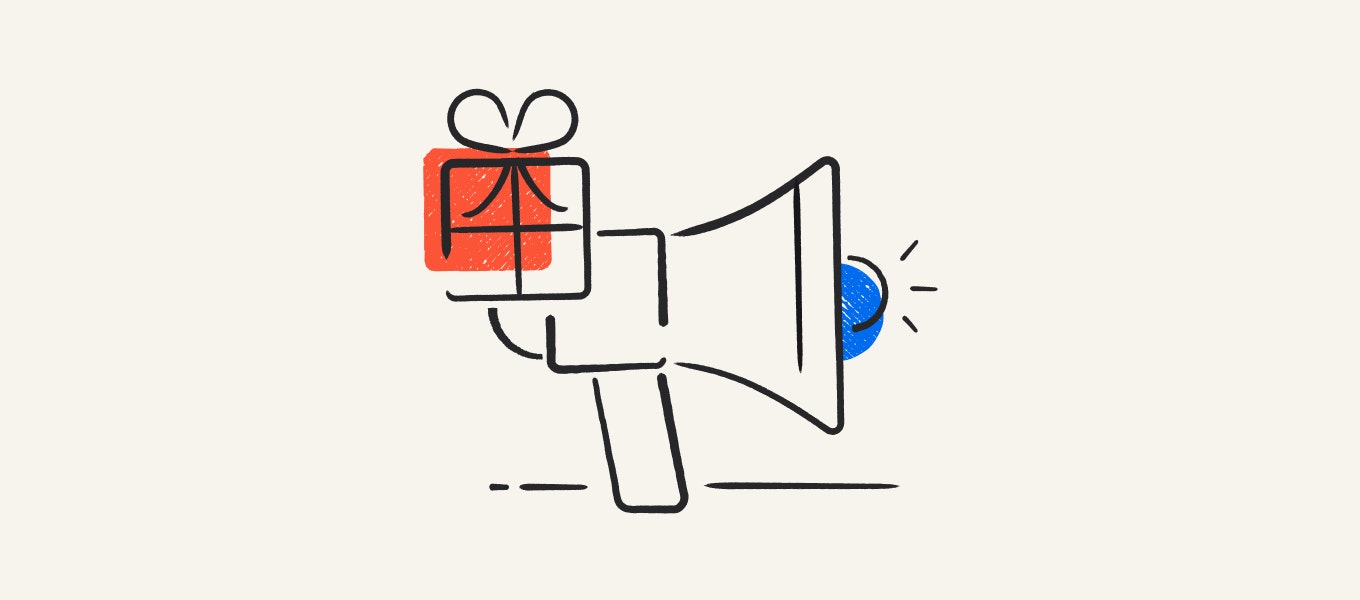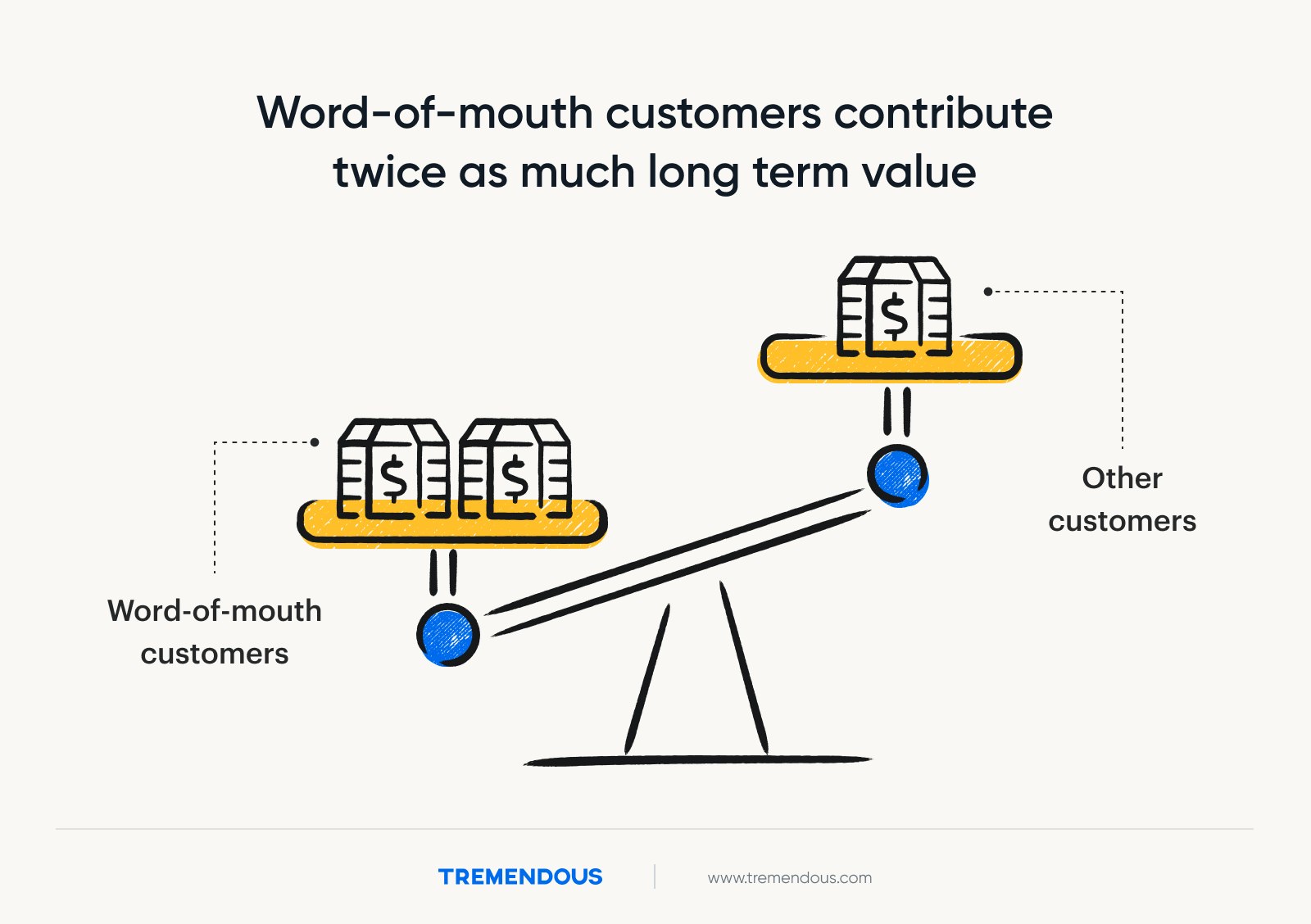Customer referrals: your highest-ROI growth lever in 2025
By Aaron Small●6 min. read●Sep 18, 2025

When a close friend or family member goes out of their way and refers a new product or service, people pay attention. A leading study published by the American Marketing Association shows that referred customers spark 31-57 % more referrals and convert better than non-referred peers.
When consumers are bombarded with marketing messages, they trust people’s opinions more than any other medium.
For brands looking to acquire more customers and build loyalty, a referral program must be part of your growth strategy. By tapping into the power of trust and incentives, you can reach new customers and accelerate growth for your bottom line.
Key takeaways:
Customer referrals leverage personal trust networks, not commercial partnerships, making them more credible than traditional advertising. Most (88% of) people trust recommendations from friends and family.
Referred customers are higher quality and cheaper to acquire. They buy 18% faster, spend 25% more, and are 37% easier to retain, yet they cost significantly less than paid channel acquisitions.
Success depends on targeting satisfied customers with dual-sided rewards and effortless sharing tools. The key is making it simple to share while rewarding both the referrer and the new customer.
Companies like Casper and ZBiotics see massive returns. Casper generated 7x higher returns than average marketing, and ZBiotics achieved 36% increased referral revenue while saving 5+ hours monthly on processing.
This guide explores the strategies of referral reward systems and the advantages and disadvantages of referral marketing.
How are customer referrals different from referral marketing?
Before diving deeper, let's clarify the distinction between customer referrals and referral marketing.
What is referral marketing? Referral marketing is a business strategy that encourages happy customers to recommend your business to others. It’s a broad umbrella that includes everything from affiliate partnerships to influencer collaborations.
What are customer referrals? These, however, are a type of referral marketing that is specifically about incentivizing your existing customers to recommend your product, service, or brand to their personal networks — friends, family, coworkers, or anyone else they trust.
With a customer referral program, everyone wins. The customer who refers a friend gets a small reward or payout from your company, you get a new (especially loyal) user, and the new customer gets an introduction to something valuable from a person they trust.
The incentive you send to customers could be anything from a discount to a gift card. And it needs to be delivered swiftly, in a format that’s easy to redeem.
Why customer referrals convert so well
The nonstop barrage of paid media leads most people to tune out traditional advertising.
Instead, customers vastly prefer to make buying decisions based on the valued opinions of those in their inner circle, like friends and family.
According to a 2025 McKinsey report, friends and family are the number one influence for product and brand recommendations in the US, Europe, and China. A Neilson study also shows that 88% of respondents across 56 countries trust recommendations from people they know.
Throwing incentives into the mix helps streamline the process, creating a referral reward program, or RRP.
What are the benefits of a customer referral program?
There are several advantages to customer referral programs over other acquisition strategies. Specifically, referred customers are cheaper to acquire, they deliver greater long-term value, and they’re more likely to actually make a purchase than customers acquired through other means. Here are the top 3 benefits of customer referral programs:
Referred customers are less expensive
The customer acquisition cost (CAC) associated with referred customers is considerably lower than CAC for customers won through paid channels, like LinkedIn ads, Google search ads, and Facebook ads. The average cost of a new customer can be anywhere from $21 to $377, depending on the industry. Meanwhile, we’ve found that you can win over a referred customer with as little as a $20 Visa prepaid card.
Higher ROI from referred customers over non-referred ones
Referred customers are a lot more likely to make purchases. Getting customers signed up for your product or service is only half the battle, as many businesses know. Encouraging customers to actually start using your product, spend more, and make repeat purchases is an entirely different challenge.
According to Prefinery data, referred customers buy 18% faster, and spend 25% more. That makes for higher lifetime value (LTV): Referred customers deliver considerably more value in the long term than non-referred customers.

When it comes to devoting marketing resources, putting in the effort to set up a smart referral program pays dividends.
More loyalty on both sides
Customer loyalty is a feeling generated by a string of positive experiences and high-quality products delivered over time. New referrals arrive on the loyalty fast track because they’ve been selected by your current satisfied customers as a natural match for your company. And the research proves it: referred customers are 37% easier to retain,
Say you’re a rock climber obsessed with your new climbing pants. You get a branded email to refer a friend and earn a discount.
What do you do? You reach out to your close climbing partners and spread the word. Maybe you meet in person or in their DMs to discuss stretchability, durability, and colors — and share your referral link.
Customer bonding is great. And it’s even greater for your bottom line.
How to get customers to refer your business: The 2025 playbook
Now that you know why referrals are important, let's dive into how to build a successful customer referral program that actually gets customers sharing.
Who should I ask first? Spotting advocates with NPS and product-usage clues
Your best customers for referrals are those with the highest NPS scores. They’re the lowest-hanging fruit and the ones you should ask first.
If you have low NPS scores, your first step is to focus on improving those. Customer satisfaction is a prerequisite for generating referrals through referral reward programs. That’s due to a phenomenon called metaperception, aka how people think others perceive them.
In this case, when people refer a service to a friend, they deeply care how they come across to that friend. The recommender’s reputation is on the line, and they don’t want to be seen as greedy or taking advantage of others. That’s why an attractive referral scheme is unlikely to fully compensate for poor service or an inferior product.
But NPS isn’t the only indicator that you have excellent referrers on your hands.
The types of customers who are ideal referral champions are those who:
Use your product regularly
Keep coming back for more (multiple purchases, upgrades, etc.)
Are already singing your praises on social media or being super nice in support chats
Have stuck around at least 3-6 months
Give you perfect 9s and 10s when you ask how likely they are to recommend you
When's a good time to ask customers for referrals?
Timing is everything. Ask for a referral at the wrong moment and you'll get crickets. Here's when people are most likely to say "yes":
Right after you've solved their problem and they're feeling the love
When they just hit a big milestone or had that "aha!" moment with your product
Fresh off leaving you a glowing review (they're already in sharing mode)
During renewals when they're actively choosing to stick with you
Right after they buy, when they're still buzzing with excitement
What rewards will make them hit "send" without hurting margins?
On average, 2.35% of customers give referrals. Reaching out to your best customers is a great way to increase referral rates, but incentives help, too. The most bang for your buck could come from rewarding both the referrer and the referred. Dual-sided incentives can boost rates by 68%, but other rewards could cost less upfront.
Other popular reward structures include:
Dual-sided discounts: Both referrer and referee get a percentage off their next purchase
Cash rewards: Direct monetary incentives via digital gift cards or cash app transfers
Loyalty points: Points that can be redeemed for products or experiences
VIP access: Early access to sales, new products, or exclusive content
Tiered rewards and gamefiction: Increasing benefits for multiple successful referrals
How do I make sharing feel effortless — no copy-paste required?
Nobody wants to jump through hoops to help you out. Make it super easy for your customers to share, and they actually will.
Best practices to make referral sharing simple:
| Customer challenge | Solution | Why it works |
|---|---|---|
| I don’t want to open an app | Social share buttons | One-click sharing eliminates the effort to open Facebook, Twitter, Instagram, and other platforms. |
| I don’t know what to say | Customizable, pre-written messages | Eliminates the blank page without locking in the message. |
| I’m not sure I’ll be paid | Unique, trackable referral links | Creates confidence and promise, while reducing work for you. |
| I don’t want to switch to a computer | Mobile-optimized experience | Turns a potentially frustrating moment into an easy, seamless share from their smartphones. |
| I don’t want to share that way | Multiple sharing channels | Allows people to connect in a variety of formats like email, SMS, social media, and messaging apps. |
Tracking the value of referrals: How do I know if it's working?
A good referral rate varies by industry and customer base. For example, enterprise SaaS companies see 1.5-3% success, while SMB-focussed SaaS companies can see 3-5% success rates.
Consistently gathering insights is essential in seeing if and how your referral program is working. Here are the top key referral program metrics you should focus on:
| Metric | Definition | What you'll learn |
|---|---|---|
| Referral conversion rate | Percentage of referral links that result in new customers | How compelling your offer is and how well you're targeting the right audience for referrals |
| Program participation rate | Percentage of eligible customers who make referrals | Whether your customers are actually motivated to share and if your referral process is user-friendly |
| Customer lifetime value (LTV) | Average total predicted profit from customers | When comparing LTV between referred and non-referred customers, can prove viability of your rewards program |
| Customer Acquisition Cost (CAC) | Average cost to persuade a prospect to make a purchase | When comparing CAC through referrals vs. other marketing channels, can prove marketing and sales savings |
| Revenue attribution | Total revenue generated from referral programs | The overall business impact and ROI of your referral program investment |
Examples of brands doing referrals well
Let's look at some real-world examples of successful customer referral programs:
Casper, an online mattress company, has seen massive success with its referral program — generating 7x higher returns than their average marketing investment. Casper’s sleep-focused approach resonates with customers who are passionate about sharing better sleep solutions with friends and family.
Tempo, selling at-home gym equipment, lowered customer acquisition costs while generating impressive new customers with its program. The personal nature of fitness recommendations makes its customer referrals particularly effective.
Byte, a direct-to-consumer orthodontics company, saw huge success with its referral program. They scored 10,000 referrals in a year with an average LTV of $2,500 each, for a total referral value of $12,500,000.
What to avoid when creating a customer referral program
Alright, now that you're fired up about referral programs, let's talk about the landmines that'll blow up your efforts before they even get started.
Common mistakes to avoid in your own referral program:
Asking too early: Hey, slow down there. Don't hit up customers for referrals when they've barely figured out how to log in. Let them fall in love with your product first.
Making rewards too wimpy: A $5 gift card isn't going to get anyone excited enough to bug their friends. Make it worth their while.
Overcomplicating the process: If your referral process requires a PhD to figure out, you've already lost. Keep it simple.
Forgetting mobile exists: Newsflash, people live on their phones. If your referral program doesn't work smoothly on mobile, it doesn't work at all.
Ghosting your advocates: When someone successfully refers a friend, celebrate them. Don't just take their effort for granted and move on.
It’s time to pull your highest-ROI lever
Customer referrals are probably the most underutilized growth hack sitting right under your nose. While everyone else is burning cash on Facebook ads and fighting over keywords, your happiest customers are waiting to become your best salespeople. You just need to ask them, at the right time, with the right incentive.
Think about it: when was the last time a friend's recommendation led you to try something new? Probably last week. That's the power you're tapping into with a well-designed referral program.
The magic formula isn't complicated: find your biggest fans, make sharing super easy, reward everyone involved, and track what's working. Do this right, and you'll have created the most cost-effective customer acquisition machine and strengthen relationships with your existing base.
Stop overthinking it and start asking. Your customers want to share good things; they just need a reason to hit send.
Manager your customer referral program with Tremendous
Partnering with a rewards platform like Tremendous makes launching and scaling your customer referral program significantly easier and more efficient. Here's why leading brands choose us:
Delight your recipients with 2000+ incentive options, including gift cards, prepaid cards, and more
Seamless, global delivery to 230+ countries with automatic currency conversion and translation
Easily upload recipients in bulk or automate sending via API, while tracking spend in real-time
Protect your marketing budget with accurate, AI-powered fraud prevention
When reward fulfillment just works, you can focus on what matters: growing your referral program and acquiring more high-value customers.
Ready to learn more? Chat with our team to see how we can help.

